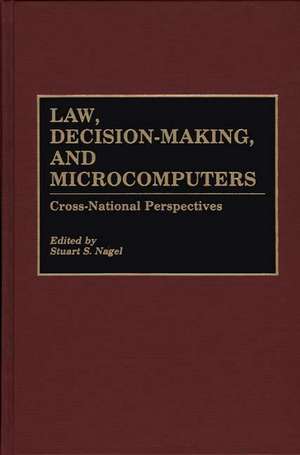Law, Decision-Making, and Microcomputers: Cross-National Perspectives
Editat de Stuart S. Nagelen Limba Engleză Hardback – 27 feb 1991 – vârsta până la 17 ani
Preț: 441.21 lei
Preț vechi: 606.15 lei
-27% Nou
Puncte Express: 662
Preț estimativ în valută:
84.44€ • 87.83$ • 69.71£
84.44€ • 87.83$ • 69.71£
Carte tipărită la comandă
Livrare economică 14-28 aprilie
Preluare comenzi: 021 569.72.76
Specificații
ISBN-13: 9780899305035
ISBN-10: 0899305032
Pagini: 376
Dimensiuni: 156 x 235 x 22 mm
Greutate: 0.7 kg
Ediția:New.
Editura: Bloomsbury Publishing
Colecția Praeger
Locul publicării:New York, United States
ISBN-10: 0899305032
Pagini: 376
Dimensiuni: 156 x 235 x 22 mm
Greutate: 0.7 kg
Ediția:New.
Editura: Bloomsbury Publishing
Colecția Praeger
Locul publicării:New York, United States
Notă biografică
STUART S. NAGEL is professor of political science at the University of Illinois, and the publications coordinator of the Policy Studies Organization. He is the author of numerous books, including Decision-Aiding Software for Legal Decision-Making (Quorum, 1989), Causation, Prediction, and Legal Analysis (Quorum, 1986), and Law, Policy, and Optimizing Analysis (Quorum, 1986).
Cuprins
Introduction: Decision-Aiding Software and the LawThe Practicing LawyerInformation Retrieval Research: How It Might Affect the Practicing Lawyer by Alan SmeatonExpert Systems--Lawyers Beware! by Ronald StamperRepercussions of Computer Technology on United States Law and Lawyers by James V. VergariPractical Applications of Document Assembly Systems by Ronald W. StaudtMicrocomputers, Decision-making and Case Evaluation by Richard GrahamThe Legal Policymaker and Public Sector UsesThe Growing Role of Computers in American Federal Tax Compliance and Administration by William J. TurnierComputerization in the Prosecution Service in Scotland by Robert G. DonaldsonA Computer System to Assist in Sentencing Convicted Offenders by David I. BainbridgeThe Courthouse of the Future by George NicholsonThe Legal Scholar and Law TrainingCourses on Computers and Law in American Law Schools by Sanda Erdelez and Paul M. HillmanUsing Microcomputers in Case-Method Law Teaching by Stuart S. NagelThe LEXICAL System for Computer-Aided Legal Instruction by Philip LeithA Hypertext System for Teaching Legal Research by I. Trotter HardyThe Computer in American Legal Education by Donald T. TrautmanCross-Cutting Analyses of the LawImplementation of Expert Systems as an Aid to Legal Decision-Making by Antonio A. MartinoAutomatic Generation of a Legal Expert System by Layman E. Allen and Charles SaxonThes-Maker: A Tool for Legal Thesaurus Building by Constantino CiampiThe Problem of Finding a Precedent by Jon BingComputers in Legal Decision-Making by David I. BainbridgeBibliographyIndex













